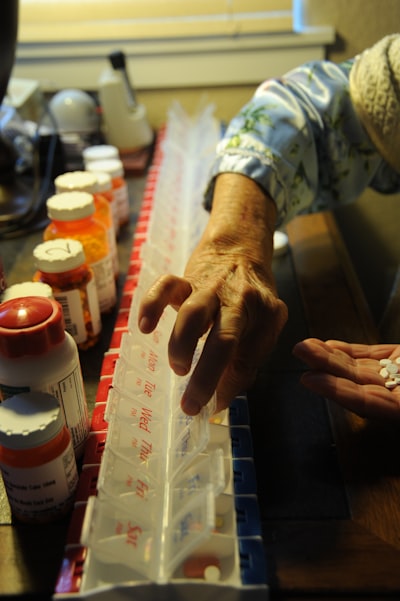Unveiling the Special Report Controversy on Drug Opioids

Key Highlights
- The opioid crisis, fueled by prescription drug misuse, is a pressing public health issue.
- A recent special report highlighting the role of pharmaceutical companies in the opioid epidemic has sparked controversy.
- The report’s findings, methodology, and implications for opioid control measures have been debated by medical professionals, regulators, and the public.
- Addressing the crisis demands a multi-pronged approach, including education, prevention, responsible prescribing practices, and support for those affected.
- Examining successful initiatives, policy recommendations, and international perspectives offers valuable insights into combating this complex challenge.
Introduction special report controversy on drug opioids

The opioid crisis drug abuse is a big problem for health in our communities. It mostly comes from the wrong use of prescription painkillers and illegal opioids. The increase in addiction and overdose deaths is worrying many people. This has led to studies and reports looking into what causes this issue. In this blog post, I will discuss a recent heated report about drug opioids. We will look at what it found and what it means for the fight against opioid addiction.
Understanding

The opioid crisis is a disease control complicated issue. Many different factors contribute to its widespread effect. To tackle this problem, we need to understand what causes it and the serious consequences that follow. We will look at the history of opioid use, the increase in prescription opioid misuse, and the harmful effects of opioid addiction on people and their communities.
The misuse of prescription opioids, along with the rise in illegal opioids like heroin and fentanyl, has created a serious public health emergency. This situation has led to many people becoming addicted and an increase in overdose death rates. The social and economic impacts of this epidemic are significant. We need to fully understand its many layers to address it effectively.
The Rise of Prescription Opioid Misuse

The opioid epidemic began when prescription opioids were used more widely. They were meant to help with pain but ended up causing many problems. Doctors prescribed these drugs too much, partly because of strong marketing and not enough education about their dangers. This made it normal for people to use opioids for long-term pain.
As more people used prescription opioids, addiction and overdose deaths also grew. These drugs are very addictive, and taking high doses can slow breathing, which can be deadly. Many people who became hooked on prescription opioids started using cheaper options like heroin and illegal fentanyl, making the crisis worse.
The increase in opioid misuse reminds us how important it is to prescribe these drugs carefully. It also shows the need for better pain management and greater awareness of the risks of opioid medications.
Key Factors Contributing to the Opioid Epidemic

Many things have come together to cause the opioid epidemic. One big factor is that there are too many illegal drugs available, like heroin and fentanyl. These strong drugs, often mixed with other harmful substances, have made overdoses much more likely in communities. This has added to the serious effects of the crisis.
Another problem is that substance abuse often connects with mental health issues and differences in wealth among people. To tackle the opioid epidemic, we need a complete plan. This plan should do more than just limit the supply of illegal drugs.
Also, health care providers are being looked at for how they prescribe opioids. While prescription opioids are important for treating severe pain, too many prescriptions and not enough checks have played a part in the crisis. It is vital for health care professionals to find a good balance between helping with pain and reducing the risk of addiction.
The Impact of Opioid Addiction on Communities

The opioid crisis has had a huge impact on communities all over the country. It goes beyond just individual battles with addiction. Many families are suffering, and there has been a rise in overdose deaths, often from drugs mixed with fentanyl. This is causing pain and hardship for many.
The financial cost of the opioid crisis is very high. Expenses from health care, lost jobs, legal issues, and social services are putting a lot of pressure on resources. This makes it harder for the economy to grow, especially in rural areas where treatment and support are hard to find.
Also, the opioid crisis has made existing problems worse, like poverty, job loss, and homelessness. To break this cycle, people in charge, health care providers, and community leaders must work together. They need to create strong programs for prevention, treatment, and recovery while also tackling the deeper issues that lead to addiction.
Historical Context of Opioid Use

The history of opioids is important to understand how they changed in medicine and led to the opioid crisis. Opioids were used early on as painkillers. They later became popular for treating chronic pain. This has led to many medical changes and some tough choices.
The way doctors prescribe opioids changed a lot. This was driven by the strong marketing from pharmaceutical companies and a bigger focus on managing pain. Looking back at this history helps to explain why there was over-prescribing and misuse of these strong pain drugs.
The controversy surrounding illicit drugs in the special report highlights the significant challenges and risks associated with drug abuse. The increase in overdose deaths, particularly due to illicitly manufactured synthetic drugs, has become a major concern. To combat this issue, it is crucial to expand access to evidence-based prevention, treatment, harm reduction, and recovery support services. Additionally, efforts should be made to reduce the supply of illicit drugs like fentanyl to address the ongoing crisis effectively.
The controversy surrounding illicit drugs in the special report highlights the pressing issue of drug abuse and its impacts on society. The rise in overdose deaths, especially due to illicitly manufactured synthetic drugs like fentanyl, has become a major concern. The Biden-Harris Administration’s drug policy priorities aim to expand access to evidence-based prevention, treatment, harm reduction, and recovery support services while also working to reduce the supply of illicit drugs in order to combat this epidemic effectively.
From Medical Solution to Public Health Problem

Opioids have been important for managing pain. They help people with sudden injuries and ongoing conditions feel better. However, the very thing that helps with pain also makes opioids easy to become addicted to. The shift from using opioids for medical reasons to seeing it as a public health issue is due to many factors.
People started using opioids widely for long-term pain. This often happened without close checking and good pain management plans. The idea that pain should go away completely, pushed by strong marketing, led to many more prescriptions. This helped create the current crisis.
It is important to understand the limits of using opioids, especially for lasting pain. By doing this, we can move toward better and more well-rounded ways to relieve pain.
Drug use has been a major factor contributing to the opioid crisis, with many individuals becoming addicted to prescription painkillers and turning to illicit drugs like heroin. The use of opioids has led to a sharp increase in overdose deaths across the United States, prompting calls for better regulation and monitoring of drug prescriptions. Additionally, initiatives focusing on harm reduction strategies, such as needle exchanges and access to naloxone, are being implemented to address the growing concerns surrounding drug use in nonurban areas.
Regulatory Changes and Their Effects
Hank Special Report Drug
In response to the growing opioid epidemic, the Department of Health and other groups have taken steps to reduce opioid prescribing. They want to lessen the crisis’s effects. Some of these actions include using prescription drug monitoring programs, educating doctors, and making overdose reversal drugs like naloxone more available.
Even though these new rules are important, there is still debate about how well they work. Some people believe that stricter rules may make it hard for patients who need pain relief to get their medication. This situation shows the need for solutions that consider both public health and personal needs.
It’s important to look at how these changes affect prescribing habits, addiction rates, and overdose deaths over time. This understanding will help improve plans and address the changing problems of the opioid crisis.
The Department of Justice has been actively involved in addressing the opioid crisis, collaborating with other agencies to combat the misuse and distribution of opioids. By working together with organizations like the CDC and FDA, efforts have been made to monitor prescription drug use and support programs aimed at raising awareness about the dangers of heroin and opioids. The Department of Justice’s role in overseeing these initiatives is crucial in implementing strategies to tackle this pressing public health issue.
The Role of Pharmaceutical Companies

Pharmaceutical companies have come under a lot of pressure for their role in the opioid epidemic. This includes how they aggressively marketed opioid medications while downplaying the risks of using these drugs long-term. Investigations and lawsuits have shown how some companies promoted their products. This raises questions about their ethics and how they may have helped cause the crisis.
Critics say that these companies chose profit over the health of patients. They argue that aggressive marketing downplayed the risks of addiction and exaggerated the benefits of opioid therapy. This made it easy for many people to get prescription opioids, leading to a rise in addiction and a significant increase in overdose deaths.
The question of whether the pharmaceutical industry is responsible for the opioid epidemic is debated. Many are calling for stricter rules, clearer marketing practices, and a stronger focus on using opioids responsibly.
Analyzing the Special Report’s Findings
The special report on drug opioids has sparked a lot of debate. This has led people to look more closely at what the report says and how it affects the fight against the opioid crisis. It explores many parts of the problem. This includes the actions of pharmaceutical companies, failures in regulation, and the social and economic effects of opioid addiction.
Yet, the findings from the report have caused discussions and raised questions about how the research was done. Some are curious about the evidence that was chosen and whether there are any biases in the findings. It’s important to look at this information carefully. We should think about different views and expert opinions to assess how valid and important the findings are.
The controversy surrounding pain medications, particularly opioids, in the medical field has sparked debates and discussions about their appropriate use. While these medications have been crucial in managing acute pain and cancer pain for decades, concerns have arisen regarding their effectiveness in treating chronic non-cancer pain. The increased utilization of opioids for long-term pain management has raised questions about their safety and potential for addiction. It is essential to consider a comprehensive approach to pain management that includes nonopioid pain medications and nonpharmacologic treatments to address this growing concern.
Evidence and Methodology Used
The report’s methods and the facts it uses have faced criticism. Some people question how the clinical trials were chosen for the study. They feel the report may not show a full or fair view of what we know about opioid therapy’s effectiveness and risks.
There are also worries about how the data is interpreted and possible biases in the findings. The opioid epidemic is complex. It is tied to social issues, economic gaps, and personal experiences. This makes it hard to look at contributing factors clearly.
It is important to closely check the report’s methods, such as where the data comes from, how the statistics were figured, and any limitations. This is necessary for a fair understanding of its findings and what they mean for future policy choices.
Controversial Aspects of the Report
One of the most debated parts of the report is about opioid withdrawal and tapering. The suggestions on tapering schedules and managing withdrawal have created discussions among doctors. Some believe that the suggested method could cause extra suffering for people with opioid use disorder.
Critics argue that the report may not fully recognize the difficulties of opioid withdrawal. This is especially true for those who struggle with complex medical or mental health conditions. It is challenging to find a way to deal with opioid overuse and addiction while providing caring and personalized medical treatment.
This debate highlights the importance of ongoing research and working together with all parties involved. A focus on the needs of patients is essential to create effective and ethical treatment plans for opioid use disorder.
Responses from Medical and Regulatory Bodies
The release of the special report has gotten many different reactions from groups working on the opioid crisis. Some organizations have praised the report. They say it highlights important parts of the epidemic and pushes for stricter rules on opioid prescribing. This is especially important because healthcare needs are changing.
On the other hand, some have raised concerns about certain findings and suggestions. They believe that these may not fit well with the current clinical guidelines or evidence-based practices. This divide in views shows how complicated the medical and ethical issues around opioid use are. It also points to the ongoing debate on the best regulatory changes in health care.
As the medical community thinks about the report’s effects, it is important to communicate openly. We need to look at the evidence fairly and focus on what is best for patients when making changes to policies.
Addressing the Roots of the Opioid Crisis
To fight the opioid crisis, we need to do more than just limit prescription opioids. We must look at the main reasons behind this issue. It’s important to tackle over-prescription and the lack of access to effective treatment. We also need to consider the social factors that lead to substance abuse.
This means putting in place complete prevention programs. We should widen access to proven treatment and recovery services. Plus, we must work on the social and economic factors that can make addiction more likely. It is vital for healthcare providers, decision-makers, and communities to work together to make real changes.
The Importance of Education in Prevention
Effective prevention strategies are key to solving the opioid crisis. Education is very important for these strategies. When people learn about the dangers of opioid misuse, it helps them understand how to use pain management safely. Talking openly about addiction can also help individuals and communities make better choices about substance use.
Educational programs should reach different groups. This includes healthcare providers, patients, families, and the general public. For healthcare providers, training should show them how to prescribe opioids responsibly. They should learn to spot signs of opioid use disorder and know about other pain management methods. Patients and families should have clear information about the risks and benefits of opioid medications. They also need to know the side effects and how to store and dispose of these medications safely.
Community education programs are also very important. They can raise awareness of the opioid crisis, reduce the stigma around addiction, and encourage people to seek help.
Strategies for Better Prescription Practices
Improving how doctors prescribe opioids is very important to reduce the risks of these drugs. Health care providers need to look at both the good and bad sides of opioid therapy for each patient. They should also think about other ways to manage pain when it makes sense. This means they need to do detailed assessments, give the lowest effective dose for only as long as needed, and closely watch patients for any signs of misuse or addiction.
Using prescription drug monitoring programs (PDMPs) is helpful. These programs keep track of opioid prescriptions. They can show patterns that might suggest misuse and help doctors share information better. By giving health care providers full details about their patients’ prescription histories, PDMPs can stop “doctor shopping” and encourage responsible prescribing.
Also, giving more options for pain management that do not use opioids is very helpful. These options include physical therapy, behavioral therapy, and other alternative medicine choices. This can help lessen the need for opioids and give patients more treatment options.
Addressing Socioeconomic Factors
The opioid crisis is closely linked to social and economic issues that lead to substance abuse. Problems like poverty, unemployment, low education, and not enough healthcare make people more likely to become addicted to opioids. These issues also create big obstacles for recovery.
To help fix these social and economic gaps, we must work on removing barriers and ensuring fairness in fighting opioid addiction. This means investing in local programs that help reduce poverty, offer job training, and improve access to education and healthcare.
By addressing the social factors that help fuel the opioid crisis, we can help people and communities escape addiction. This will lead to a healthier and stronger future for everyone.
Legal and Regulatory Framework
The laws and rules around opioids are very important in dealing with the opioid crisis. The laws about how opioids are prescribed, distributed, and used differ a lot from state to state and also at the national level. This creates a mix of rules that can confuse both patients and healthcare providers.
To properly tackle the opioid crisis, we need a strong and clear legal system. This means improving prescription drug monitoring programs, setting clear rules for opioid prescribing, and making sure everyone affected has access to effective treatment and recovery services.
Current Laws Governing Opioid Prescription
The United States is dealing with a complicated and changing set of laws about how opioids can be prescribed. This situation aims to meet people’s needs for pain relief while also caring about public health. The Controlled Substances Act is the main law that regulates drugs like opioids, putting them into categories based on how likely they are to be abused and their medical uses.
Recently, both state and federal laws have been created to tackle the opioid epidemic. These new laws look at several areas. They limit opioid prescriptions for short-term pain, require doctors to learn about the guidelines for prescribing opioids, and make it easier for people to get naloxone, a medicine used to reverse overdoses.
While these laws are important to fight the epidemic, it can still be tricky to understand them for both healthcare providers and patients. Keeping up with the latest information on opioid prescribing laws, making sure everyone follows these rules consistently, and encouraging teamwork among all parties are needed steps for improving the effectiveness of these laws.
Effectiveness of State and Federal Efforts
State and federal efforts to fight the opioid crisis have had mixed results. Some programs are working well, while others are struggling to keep up with this changing public health issue. Many states have made great progress in improving access to treatment, setting up prescription drug monitoring programs, and cutting down the number of opioid prescriptions given out.
For example, states that have started mandatory prescription drug monitoring programs have reported fewer opioid prescriptions and a decline in overdose deaths linked to opioids. On the federal level, programs such as the SUPPORT for Patients and Communities Act have provided money to expand treatment access, support research on non-opioid pain management, and help infants born with neonatal abstinence syndrome.
Still, the opioid epidemic is complex. Its connection to social health factors and ongoing treatment access challenges show that we need a long-term and varied approach in the future.
Potential Reforms and Their Implications
As the opioid epidemic changes, we need to update our strategies to fight it. Policy reform is very important in this ongoing fight. We need to find a balance between reducing harm, making sure people can access pain relief, and supporting long-term public health goals.
One area we can work on is making treatment for opioid use disorder easier to access. This means providing more medication-assisted treatment (MAT), fixing the issues with how people access treatment, and bringing addiction treatment into regular healthcare.
Also, policies should focus on harm reduction. This includes making naloxone easier to get, supporting syringe exchange programs, and allowing safe places for injections. These methods have shown that they can lower overdose deaths, stop the spread of diseases, and help link people to treatment services, even if they often face pushback from politicians and society.
The Role of Healthcare Providers

Healthcare providers are at the front line of the opioid crisis. They must manage pain responsibly while also considering the risks of addiction linked to opioid therapy. It is important to educate these providers on safe opioid prescribing guidelines and other pain management methods that do not rely solely on opioids. This knowledge can help stop over-prescribing and reduce new cases of opioid use disorder.
Also, healthcare providers are key in spotting and treating opioid addiction. By noticing the signs of opioid use disorder, they can show compassion and help those who need support. Providers can connect patients with effective treatment options, making a big difference in their lives and helping them take back control.
Challenges in Managing Pain
Chronic pain is a big challenge for both patients and healthcare workers. Pain is personal and hard to measure and manage. Many doctors worry about adding to the opioid crisis. This worry can make them hesitate to prescribe opioids even when they might be needed. To find the right way to manage pain for each person, we need to look at the physical, emotional, and social parts of chronic pain.
Healthcare workers must find a way to help people in pain while being careful with opioid medications. Good communication, teaching patients about their treatments, and making decisions together are very important to handle this issue.
Investing in research and training for healthcare workers on non-opioid pain management methods is key. This includes options like physical therapy, cognitive-behavioral therapy, and other alternative treatment methods. It will help broaden the choices we have to treat chronic pain in safe and effective ways.
Alternatives to Opioid Prescriptions
As the healthcare world looks for better ways to handle chronic pain, many people are recognizing and accepting non-traditional treatments. Unlike opioid therapy, which mainly hides pain signals, these alternative options take a whole-person view. They consider the physical, mental, and social parts of a person’s pain.
Non-opioid medicines, like nonsteroidal anti-inflammatory drugs (NSAIDs) and some antidepressants, can help with specific types of pain, especially inflammatory and nerve pain. Physical therapy, often forgotten in usual pain treatment plans, is very important. It helps to build strength, improve flexibility, support mobility, and reduce pain.
Cognitive-behavioral therapy (CBT) is a kind of therapy that helps people learn how to deal with their pain. It focuses on changing thoughts, feelings, and actions that can make pain worse. Techniques like mindfulness-based stress reduction, acupuncture, and other complementary and alternative medicine (CAM) methods have also shown potential to offer relief and improve the lives of people dealing with chronic pain.
Best Practices for Monitoring and Support
When opioids are needed, healthcare providers must follow best practices. This helps monitor patients and reduce risks while using the medication. Good patient monitoring is important to spot possible misuse, avoid overdoses, and keep patients safe.
Before starting opioid therapy, providers should carefully check medical histories and assess the risk of opioid use disorder. They should also set clear treatment goals. After starting therapy, providers should regularly monitor patients. This can include urine drug tests, counting pills, and having follow-up appointments. These steps help track how well patients are sticking to the plan and catch any unusual behavior.
It’s also very important to give patients ongoing support and resources during treatment. Having patient education materials and tools to manage side effects is key. Good communication with healthcare providers helps patients be involved in their care and feel comfortable asking for help when they need it.
Community and Individual Responsibilities
The opioid crisis needs all of us to work together through policies and healthcare systems. It’s also very important for communities and people to be involved. We need to raise awareness about the dangers of opioid misuse. We should promote safe ways to store and dispose of medication. It’s crucial to build a supportive culture for those who are affected.
Everyone can help by learning about the risks of opioids and sharing that knowledge with their families. We can also push for responsible prescribing in our communities. Reducing the stigma around addiction is vital too. If we join forces, we can create a caring environment. This will help individuals, families, and communities prevent and overcome opioid addiction.
Raising Awareness and Reducing Stigma
Stigma about addiction can make it hard for people to get help for opioid use disorder. It stops many from finding treatment and support services. To fight this stigma, we need to talk about what addiction really is. We should challenge false beliefs and use kind, respectful words when talking about substance use disorders.
Public awareness campaigns can help. They can share stories of recovery, teach communities about the science of addiction, and spread messages of hope. These efforts can change how people think and create a better environment for those dealing with this public health crisis.
It’s important to know that addiction is a medical issue, not a failure of character. By understanding more, showing kindness, and standing up for those with opioid addiction, we can build communities that focus on health, healing, and recovery.
Support Systems for Affected Individuals and Families
The opioid crisis affects not just the person with an addiction, but also their families and communities. Family members often carry a heavy load. They face emotional pain, money problems, and strained relationships while they try to help their loved ones through addiction and recovery.
It is important to create strong support systems for people and families impacted by the opioid crisis. These systems give necessary help, resources, and a sense of belonging during tough times. Groups like Nar-Anon and Al-Anon provide safe places where family members can connect. They can share their stories and learn ways to cope with the challenges of loving someone with a substance use issue.
Also, giving families access to educational resources, counseling, and temporary care can help lessen their overwhelming burden.
Community-Based Solutions and Initiatives
Empowering communities to create and use their own solutions is important for handling the special issues created by the opioid crisis in different areas. Community programs often bring together healthcare providers, law enforcement, social services, and local people. They work together to build a support system that helps stop substance abuse and assists those in need.
One effective method is the creation of drug courts. These courts offer a different option than jail for people with substance use disorders. Drug courts mix court supervision with treatment and support. This helps people recover while lowering repeat offenses and lightening the load on the criminal justice system.
Also, community groups that focus on preventing substance abuse, educating others, and raising awareness can greatly help. They can create healthier spaces and give people the power to make smart choices.
Technological Innovations in Treatment

Technological advancements are becoming very important in helping people with opioid use disorder get treatment and achieve better results. Telehealth services, for example, help connect patients in remote areas or those who have trouble moving to doctors trained in addiction care.
Digital platforms, such as apps for sticking to medication and online support groups, provide new ways to track opioid use. They offer immediate help and help stop relapses. These technologies can greatly change addiction treatment and boost patient involvement, especially in places where standard healthcare is hard to get.
Digital Health Solutions for Monitoring
Digital health technology is changing how we watch over opioid use. It offers new ways to help patients stick to their treatment plans and can help catch problems early. For example, smart pill dispensers keep track of when people take their medicine. They can alert doctors if someone is using the medication incorrectly or not following what was prescribed.
Mobile apps and wearable devices also help track opioid use. They monitor important signs, like heart rate, breathing, and sleep. These signs can warn us about possible overdose risks or relapses. The information collected by these tools helps doctors understand patients better. This way, they can create more personal treatment plans and act before issues arise.
By using digital health tools to monitor opioid use, doctors can keep patients safer, help them stick to their treatments, and work to lower the number of overdoses and deaths related to opioids.
Advances in Non-Opioid Pain Management
The medical community is looking for safer and more sustainable ways to manage pain. Recent developments in non-opioid pain management are becoming good options compared to traditional opioid therapy. This is especially helpful for people with chronic pain conditions.
New medical techniques, like neurostimulation and regenerative medicine, offer exciting treatments that focus on the real reasons for pain. For example, spinal cord stimulation works by putting in a device that sends electrical signals to the spinal cord. This helps block pain signals from reaching the brain. It shows great results for treating chronic back pain, nerve pain, and other conditions that do not respond well to regular pain management.
Another interesting area is stem cell therapy. This method uses the body’s own healing skills to fix damaged tissues and lessen inflammation. It may give people with chronic pain long-term relief. As research in these fields continues, we can expect even more excellent breakthroughs in non-opioid pain management.
The Future of Addiction Treatment Technologies
The future of addiction treatment is set for big changes. Technology is changing healthcare and creating new ways to tackle addiction’s many challenges. Improvements in artificial intelligence (AI) and machine learning could help make treatment plans more personal. They may also help predict when someone might relapse and support long-term recovery efforts.
AI chatbots and virtual helpers are being used to provide support around the clock. They can offer personal coping strategies and connect people with the right resources that fit their needs and progress. This technology can help make treatment more accessible, especially for those living in rural or less-served areas. It ensures ongoing support throughout the recovery process.
Also, virtual reality (VR) and augmented reality (AR) technologies are being used to create engaging therapy experiences. These can simulate real-life situations that may cause cravings. This lets people practice their coping skills in a safe and controlled setting.
Case Studies: Successes and Failures
Learning from past experiences, whether they are successes or failures, is very important in improving ways to fight the opioid crisis. Looking at case studies of programs that have made good progress in lowering opioid overdoses or increasing access to treatment can give us useful ideas. These ideas can be used in other areas.
On the other hand, studying programs that did not meet their goals can show us what mistakes to avoid. This reminds us that we need to keep evaluating, adjusting, and involving the community to create strong responses to this complicated public health issue.
Programs That Have Made a Difference
Amid the ongoing challenges of the opioid epidemic, looking at successful programs gives us hope. These programs also teach us lessons we can use in other communities. One example is “Project Lazarus” in North Carolina. It took a full community approach that included teaching doctors, monitoring prescription drugs, and making naloxone more available.
Another good program is the Law Enforcement Assisted Diversion (LEAD) program, which started in Seattle. It helps people with minor drug offenses by guiding them away from the criminal justice system and into community care and support services. LEAD has shown it can lower repeat offenses, improve public safety, and connect people to the right help.
These programs show that when different groups work together, focus on proven methods, and consider the needs of their communities, they can really help fight the damage caused by the opioid epidemic.
Lessons Learned from Less Successful Initiatives
It’s important to celebrate we are making progress in fighting the opioid crisis. However, looking at the initiatives that didn’t do well can teach us valuable lessons for the future. These reflections help us avoid making the same mistakes again.
For example, some efforts only try to lower opioid prescriptions. They do not also increase access to treatment and support. This can result in driving people to illegal drugs or leaving them with untreated withdrawal symptoms. Additionally, when decisions come from high up without community input, they often miss the real social issues affecting health. This leads to less success and prevents lasting change.
By understanding why these efforts struggle, we see why we need better approaches. These new methods should focus on harm reduction, get communities involved, and tackle the main causes of addiction.
Adapting Strategies Based on Evidence
In the changing situation of the opioid epidemic, one key lesson is the need to adapt and use proven methods for our actions and resource use. What helps one community may not work the same way in another. This is why we need a data-driven method to make informed decisions and adapt our strategies to fit each unique situation.
We should keep checking and measuring important signs, like how many opioids are prescribed, the number of overdoses, and percent of people getting treatment. This helps us see how well our current actions are working and lets us make changes when needed. For example, if we find an increase in overdoses in a certain area, we may need to shift resources to provide more naloxone or focus on targeted harm reduction programs.
By using an adaptive approach based on evidence, we can go beyond a one-size-fits-all plan. We can make flexible strategies to face the ongoing challenges of the opioid epidemic.
Policy Recommendations for Future Action

Tackling the opioid crisis needs a well-rounded approach. Good policy suggestions are key to guiding resources, encouraging teamwork, and supporting lasting solutions. These suggestions should focus on proven strategies that help cut down opioid misuse, allow more people to get treatment, and support families affected by addiction.
Important policy goals should be:
- Strengthening prescription drug monitoring programs.
- Making it easier for people to access medication-assisted treatment (MAT).
- Using harm reduction strategies.
- Investing in prevention and education programs.
Strengthening Prescription Drug Monitoring Programs
Prescription drug monitoring programs, or PDMPs, help doctors fight the opioid crisis. They do this by giving healthcare workers clear information about patients’ prescription histories. This helps them spot warning signs of opioid misuse or illegal activity. However, we need to make PDMPs even stronger.
One important suggestion is to require that all doctors use PDMPs. Right now, not all states ask doctors to check these programs before they write prescriptions for controlled substances. If every doctor has to use PDMPs, they will get the best and newest information about their patients’ prescriptions. This will help them make better choices and may help them find people who might misuse opioids.
Also, we should encourage the sharing of data between state PDMPs. This would help stop the problem of “doctor shopping.” This happens when someone goes to different doctors in different states to get several prescriptions and avoid limits or hide misuse.
Enhancing Access to Treatment and Recovery Services
Expanding access to proven treatment and recovery services is very important for tackling the opioid epidemic. This means we need to take several steps. First, we should make it easier to get medication-assisted treatment (MAT). Next, we need to have more residential and outpatient treatment centers. Lastly, we must fix insurance coverage issues for addiction services.
Medication-assisted treatment (MAT) uses medicines like methadone, buprenorphine, and naltrexone along with counseling and therapy. It is very effective at cutting down opioid use, preventing overdose deaths, and helping with long-term recovery. However, access is still limited. This is because of rules, social stigma, and not enough qualified providers.
Policy changes should aim to reduce these obstacles. We need to encourage providers to offer MAT and boost funding for research and training programs. This will help us grow the workforce that can provide these important treatments. Fixing insurance coverage problems is also essential. We should create rules that guarantee equal coverage for addiction treatment and ensure all aspects of care are paid for. This will help remove money issues and allow everyone to get the treatment they need.
Fostering Interagency Collaboration
The opioid crisis is complicated. It needs many groups to work together. This includes public health agencies, law enforcement, healthcare workers, social service organizations, and community groups. Strong teamwork is important. It helps share resources, improves communication, and puts effective public health plans into action.
Creating task forces or coordination councils can help bring together people from different areas. This way, they can share information and avoid doing the same work twice. It’s also important to have clear communication between agencies. Sharing data from prescription drug monitoring programs (PDMPs) with law enforcement is helpful. Connecting people who leave the criminal justice system with the right treatment services is also key for prevention and help.
The Impact of Media on Public Perception
Media is very important in shaping how people view the opioid epidemic. News stories affect policy choices and show that we need to act quickly against opioid misuse. Advocacy campaigns help people learn about the dangers of opioid abuse. If the media shares wrong information, it can cause serious problems, so we need accurate reporting. Public health programs should work with media to spread trustworthy information and fight misinformation. By knowing how media affects opinions about opioids, everyone involved can create better messages for education and prevention.
Reporting Trends and Their Effects on Policy
The changing world of media reporting has a big impact on decisions about the opioid epidemic. News stories can shape how people think, which affects how we use resources to fight opioid misuse. When reporting is overly dramatic, it can increase fear and stigma around opioid use. This can hurt the use of effective treatment strategies.
On the other hand, fair reporting that focuses on proven solutions can help push for policy changes that support public health. Sharing success stories of people who have beaten opioid addiction can also motivate the creation of helpful policies for those trying to recover. So, it is important to promote accurate and clear media stories to encourage good policy changes in tackling the opioid crisis.
The Role of Advocacy and Awareness Campaigns
Advocacy and awareness campaigns are very important in fighting the opioid epidemic. They help educate people about the risks of opioid misuse and promote good treatment choices. These campaigns work to reduce the negative feelings around substance use disorders. They also encourage people to ask for help. By teaming up with healthcare providers and community groups, these efforts aim to provide more resources for those facing opioid use disorder. It is also key to raise awareness about the risks tied to prescription opioids and to share ways to manage pain without opioids. This can help stop addiction before it starts. Overall, the effect of advocacy campaigns is crucial in tackling the many problems brought by the opioid crisis.
Misinformation and Its Consequences
Misinformation about opioids can make the opioid epidemic worse. This can have serious effects. Wrong ideas about opioid therapy can lead to wrong prescriptions. This can cause people to misuse opioids and even lead to overdose deaths. The spread of misinformation makes it harder for public health to tackle the opioid crisis. People might be confused about the risks and benefits of opioid use, which could harm them. It is important to fight misinformation by providing accurate information through education and awareness campaigns. This will help people understand how to use opioids safely and what might happen. We must address misinformation to reduce its harmful effects on the well-being of society.
International Perspectives on Opioid Control
Countries around the world handle opioid control in many ways. This shows different cultures and policies at work. By comparing these strategies, we can see how some countries do better at fighting misuse.
Low-misuse countries provide helpful lessons that can be copied. To tackle drug trafficking, global teamwork is key since opioid problems cross borders. Different international efforts attempt to solve the opioid epidemic by using new ideas and working together.
Policymakers can learn from these various methods to create strategies that fit their own situations and apply effective practices. Understanding international views can help navigate the complicated world of opioid management.
Comparative Analysis of Different Regulatory Approaches
Countries around the world use different rules to fight the opioid epidemic. Some countries have strict guidelines for prescriptions. Others focus more on harm reduction programs. For example, the United States has a complicated system with both federal and state rules. This is different from Canada, which has a more centralized system. In European countries, the approach is more about public health. They include addiction treatment in regular healthcare services. In contrast, many Asian countries focus more on law enforcement to stop illegal drug trafficking. It is important to understand these differences. This helps in creating solutions that meet the unique challenges of each area. By looking at these different rules, we can learn how to better address the opioid crisis globally.
Lessons from Countries with Low Rates of Opioid Misuse
Countries with low levels of opioid misuse offer useful lessons on how to tackle this issue. Looking at their methods shows important ways to fight the opioid epidemic. These countries focus more on public health than punishment. They emphasize prevention and treatment. They create complete programs that involve healthcare providers, human services, and education systems. By focusing on mental health and substance abuse services, they work on the real causes of addiction. Sharing successful strategies worldwide can make global efforts stronger. Learning from these positive examples shows that a complete approach is essential to deal with opioid misuse.
Global Cooperation Against Drug Trafficking
International collaboration is very important in the fight against drug trafficking. When different countries work together, they can strongly affect the spread of illegal drugs like opioids. Sharing information, resources, and strategies helps law enforcement become more effective against drug trafficking networks. By joining forces, law enforcement can break up the supply chain and help stop the spread of harmful drugs. Global programs focus on the worldwide problem of drug trafficking and show that a united approach is key to solving this tough issue. By working together, countries can improve rules and enforcement to reduce the flow of illegal opioids everywhere.
Future Directions in Opioid Research
Exploring new ways to do research is very important for improving opioid science. When we find gaps in what we know now, we can help future studies create better treatment plans. It is key to understand new trends in opioid misuse and addiction so we can customize our help. Researchers can gain a deeper understanding by including different viewpoints. Working together with various groups will help us fully address the opioid epidemic. Using new technologies and methods can change how we study opioid use disorders. Joining forces across different fields may lead to great breakthroughs in fighting the crisis. Keep an eye out for new updates in opioid research.
Identifying Gaps in the Current Knowledge Base
One key part of fixing the opioid epidemic is finding what we do not know. It is important to understand how opioids are prescribed and how they can be misused. We also need to learn about the best ways to treat this issue. Right now, we do not have enough research on alternative treatment options, behavioral therapy, and when opioids can help with certain health conditions. We must look deeper into how health care providers prescribe opioids and what leads to their misuse. To fight the opioid crisis well, we need to understand the important issues better and come up with smart strategies.
Emerging Trends in Opioid Misuse and Addiction
Emerging trends in opioid misuse and addiction show changes in public health. The rise in opioid use disorder is causing new issues for health care providers. It is important to understand how to prescribe opioids and the role of behavioral therapy in tackling the opioid epidemic. As people look more at alternative treatment options and the benefits of opioids, we need clear guidelines for clinical practice. Keeping up with these trends is vital for creating better ways to fight drug addiction and misuse.
Innovative Research Methods for Better Understanding
Innovative research methods are very important for helping us understand the opioid epidemic. New methods like data mining and machine learning give us great insights into how opioids are misused. By looking at large amounts of data, researchers can find groups at high risk and create better intervention plans. Additionally, neuroimaging studies give important details about the brain’s role in addiction, helping us see where potential treatments could be. Working together in teams from different fields also makes our findings more reliable and useful. By using these new methods, we grow our knowledge and move closer to effective ways to fight the opioid crisis.
Personal Stories from the Front Lines
Experiences from people on the front lines give us deep insights into the opioid epidemic. Healthcare professionals see the tough challenges of withdrawal symptoms and the issues related to opioid use disorder. Recovering users tell their brave stories, showing the hard times they faced with addiction and their journey to recovery. Families and caregivers share the painful effects of opioid misuse on their loved ones, highlighting the urgent need for effective treatment and support. These personal stories make the crisis more real. They show why we need a complete approach that includes mental health, addiction treatment, and strong community support.
Experiences of Healthcare Professionals
Healthcare workers dealing with the opioid epidemic face many tough challenges every day. They must manage pain in a complicated way and help with opioid withdrawal symptoms. They play a key role in reducing the crisis. The stress of providing good treatment while trying to prevent opioid misuse is very high. These workers see the terrible effects of opioid overdose deaths in their communities. They fight for better ways to handle substance abuse and work on opioid use disorder support. Their work shows the need for strong public health efforts. It also shows why teamwork among different groups and organizations is important. Healthcare providers are crucial in changing how opioids are prescribed to improve patient care and community health.
Recovering Users’ Perspectives
Listening to people who have fought opioid addiction can help us understand their problems and successes in recovery. Many recovering users talk about the tough fight against withdrawal symptoms and the fear of relapse that stays with them. Their stories show us that we need better treatment options and more support from healthcare providers and community services. Numerous individuals discuss feeling judged by society and the healthcare system. This highlights how important it is to have a caring and understanding approach to addiction. Knowing these personal stories is key to creating more empathetic ways to tackle the opioid epidemic.
Impact on Families and Caregivers
The opioid epidemic affects families and caregivers very deeply. It brings a lot of emotional pain and practical issues. Watching a loved one fight opioid addiction can be heartbreaking. This often makes people feel helpless and very stressed. Caregivers have to deal with the effects of opioid misuse. They face financial problems and have to handle complicated healthcare systems. There is also a constant fear of overdose deaths, which creates worry and anxiety in families. Supporting those with opioid use disorder is important, but it can hurt the mental and physical health of those who care for them.
Conclusion
The opioid epidemic has had a serious effect on public health. There is a report discussing drug opioids that calls for a full review of our current policies. Many factors are involved, such as how opioids are prescribed and the influence of pharmaceutical companies. This calls for a broad approach to create effective treatments and prevention plans. There is also a lot of misinformation and stigma around opioid use disorder. This shows how important it is to improve awareness and ensure people have access to good care based on facts. To fight this crisis and decrease the rise in overdose deaths, healthcare providers, policymakers, and communities must work together in a unified way.
Frequently Asked Questions
What are opioids and why are they controversial?
Opioids are a group of drugs that help with pain relief. However, they can be addictive, which has caused many debates. When people misuse them, it can lead to addiction and overdose deaths. This raises important worries about public health and how to respond to the problem. It’s important to understand their effects to tackle this complicated issue.
How did the opioid crisis start?
The opioid crisis started in the late 1990s. During this time, pharmaceutical companies promoted prescription painkillers heavily. This led to many people misusing these medications. Some reasons for this problem include too many prescriptions, weak rules, and patients becoming addicted. This situation caused serious social and health issues.
What is being done to combat the opioid crisis?
Efforts to fight the opioid crisis focus on several key actions. These include making regulations tougher, improving access to treatment for addiction, raising public awareness, and better monitoring of prescription drugs. It is important for healthcare workers, lawmakers, and law enforcement to work together. This teamwork is essential in tackling this complicated issue.
Can opioid addiction be treated?
Opioid addiction can be treated using medications, therapy, and support programs. The goal of the treatment is to help manage withdrawal symptoms, lower cravings, and avoid relapse. It is important to get professional help for a treatment plan that fits your needs.
How can individuals help prevent opioid misuse?
Encouraging the right way to throw away medicine, teaching how to store it safely, and promoting pain management options that do not use opioids are important steps people can take to stop opioid misuse. It is crucial to raise awareness about the dangers and to support those who are dealing with addiction. These actions are key in fighting against this problem.
https://doi.org/10.1057/biosoc.2016.7
https://pubmed.ncbi.nlm.nih.gov/26316838
https://www.cdc.gov/policy/hst/hi5/cleansyringes/index.html
https://grants.nih.gov/grants/guide/rfa-files/RFA-FD-23-034.html
https://www.cdc.gov/drugoverdose/prescribing/guideline.html
https://grants.nih.gov/grants/guide/rfa-files/RFA-FD-23-035.html
https://grants.nih.gov/grants/guide/rfa-files/RFA-FD-22-027.html
https://grants.nih.gov/grants/guide/rfa-files/RFA-FD-20-029.html
https://www.justice.gov/opioidawareness
https://grants.nih.gov/grants/guide/rfa-files/RFA-FD-24-025.html
